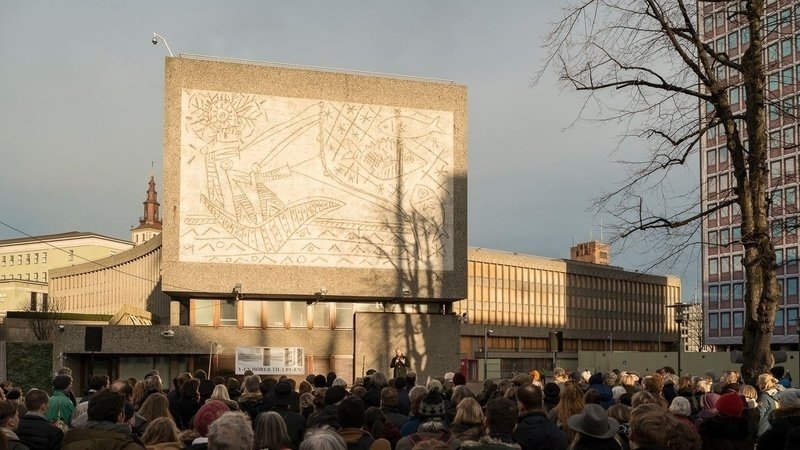Going Public: An Introductory Text
Physical and social distancing has caused some interesting news in Norway lately. Retired Ellen de Vibe, who was director of Oslo City’s Department of Urban Development until June 2019, protested peacefully on 28 April – and with safe distance to the four other protestors – the demolition of the Y-block built in 1969 [Save Oslo's Y-block with Murals by Picasso]. Interesting because of its function as a government building, but also for its materials and history – chiefly because of the large-scale concrete murals by Pablo Picasso and Carl Nesjar as well as for its role in the terrorist attack of 22 July 2011. The five protestors were removed forcefully by police, and also served a fine of NOK 12.000.

This case brought new light to a text published through the online journal Kunstkritikk as part of their series of essays on the 2010s seen from a Nordic perspective a few days before the protest. Through the text Going Public I argue that collective action replaced individual visions as the agent of change in art institutions during the 2010s. Since 2008 ‘trust in – and respect for – public institutions dwindled as states proved unable to hold the guilty parties [to the financial crisis] accountable, and the way economic, legal, and political institutions were perceived changed. Even if the exposure of the state’s weak position in relation to the financial market ought to have caused changes in the logic of public institutions – including cultural ones – across the board, it is difficult to trace radical changes in art institutions, and the Western art institution in particular. It seems that art has survived the ‘detonation’. Upon closer scrutiny, however, cracks are beginning to show.’
In the decades preceding the financial crisis curators had contributed to ‘the creation of new methods for meaning production within the institutions. During the [2010s], however, it became obvious that perceived autonomy was being replaced by complex entanglements. The intricate networks arising from globalisation, together with the awareness that neoliberal self-realisation no longer presented a solution, led to a new sense of solidarity and to internal alliances which would replace the self-organisation previously revered. At the same time, institutions were both weakened and strengthened by networks intensifying other concerns than those pertaining to the profession itself.’
‘Yet, in the 2010s a marked collective disgruntlement with institutions that operate according to logics belonging to the period before 2008 can be traced. As there was no comprehensive economic overhaul of the art field, the art market kept – and even strengthened – its influence. […] As ‘Melissa Gronlund writes: “Instead of making protest works, artists are now protesting. They are responding to the infrastructural ties between the realms of culture and those of conflict – whether military, financial or ecological.”’
‘Artists withdrawing works from exhibitions or from art prize nominations send strong signals which become exponentially more powerful when they spread digitally. The digital commons expands the artist’s range of action. Digital ‘democracy’ facilitates mobilisation for single issues and opens up a horizon of experience beyond the physical. At the same time, it makes it possible for anyone to get organised. Yet, the day where examples like those mentioned [in the text] will provoke radical changes in the art institution, is still far into the future.’
‘Even if the campaigns presented here are praiseworthy for their active resistance to dirty capital and defence of the principle of autonomy, no viable course has been established for translating the work made on a microlevel to the macrolevel, nationally or internationally. In order to provoke a well-organised – and for some, dramatic – conclusion to this long decade, we might have to analyse the art institution with long-term changes in mind. The idea might not be revolutionary, but perhaps the crisis we currently find ourselves immersed in can re-establish a broader community capable of offering a more unified resistance to the dismantling of the art institution that we are witnessing – or enable us to collectively imagine long-term alternatives together, with room for complexity and nuance, simply because the crisis touches us all and has put discrimination and privilege in even more glaring contrast to each other.’
Going Public was published by Kunstkritikk in Norwegian and English. Originally written in Norwegian, translated by Anders Dunker.

Anne Szefer Karlsen is an individual member of CIMAM, a curator, editor, writer, and Professor in Curatorial Practice at the Faculty of Fine Art, Music and Design, University of Bergen. Szefer Karlsen’s writing has appeared in journals such as Afterall, Billedkunst, and Kunstkritikk, and in artist monographs, as well as anthologies such as Plasticity of the Planet: On Environmental Challenge for Art and Its Institutions (Mousse Publishing, 2019), and Of(f) Our Times: Curatorial Anachronics (Sternberg Press, 2019). Her current research circles experiences of living in petrostates, for an upcoming international group exhibition at Stavanger Art Museum, Norway, autumn 2021.